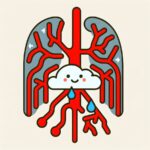Respiratory Distress Syndrome (RDS) is a common concern among newborns, especially in premature babies. It’s a condition that affects the lungs, making it difficult for the baby to breathe. This guide is crafted to help new parents understand RDS, its causes, symptoms, treatment options, and ways to support their child through this condition.
What is Respiratory Distress Syndrome?
Respiratory Distress Syndrome, also known as Surfactant Deficiency Disorder, primarily affects premature infants. It occurs due to insufficient production of surfactant, a liquid that coats the inside of the lungs and helps keep them open so that oxygen can be absorbed. Without enough surfactant, the baby’s lungs can collapse, leading to breathing difficulties.
According to the National Center for Biotechnology Information, RDS is most common in babies born before 37 weeks of gestation. The risk decreases significantly as the gestational age increases.
Signs and Symptoms of Respiratory Distress Syndrome
Identifying the signs of RDS early can be crucial for the wellbeing of your baby. Symptoms usually manifest shortly after birth and may include rapid, shallow breathing, a sharp pulling in of the chest below the ribs with each breath, a grunting sound when exhaling, nasal flaring, or a bluish skin color due to lack of oxygen.
If you notice any of these symptoms in your newborn, it’s imperative to seek medical attention immediately. Early diagnosis and treatment can significantly improve the outcome for babies with RDS.
Treatment Options for Respiratory Distress Syndrome
Treatment for Respiratory Distress Syndrome aims to support the baby’s breathing and ensure they receive enough oxygen. Common treatments include supplemental oxygen, surfactant replacement therapy, and mechanical ventilation. In some cases, doctors may use Continuous Positive Airway Pressure (CPAP) to keep the lungs open and filled with air.
Advances in medical science have significantly improved the prognosis for babies with RDS. According to studies, early administration of surfactant and the use of less invasive respiratory support techniques have contributed to better outcomes.
Preventing Respiratory Distress Syndrome
While it’s not always possible to prevent RDS, there are measures that can reduce the risk. For expectant mothers at risk of premature delivery, doctors may administer steroids to accelerate lung development in the fetus. Adequate prenatal care, avoiding cigarette smoke, and managing maternal health conditions are also critical.
It’s important for parents to be informed and prepared. Learning about prematurity and its implications, including RDS, can empower you to make informed decisions about your baby’s care.
Supporting Your Baby Through Respiratory Distress Syndrome
Having a baby in the NICU due to RDS can be a challenging experience for parents. It’s essential to be an active participant in your baby’s care, communicate regularly with the healthcare team, and seek support for yourself.
Understanding conditions like apnea, acid reflux, and anemia which may co-occur with RDS, can also prepare you for potential complications and the comprehensive care your baby might need.
In conclusion, while Respiratory Distress Syndrome is a serious condition, advances in neonatal care and treatment have significantly improved outcomes for affected newborns. By being informed, vigilant, and engaged with your baby’s care team, you can navigate this challenging time and support your baby’s health and development.













